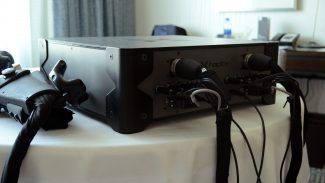Having both the haptic (touching) and force feedback (gripping) information conveyed through your hands also means that you don’t need to rely completely on your eyes for that information, which opens the door to reliably manipulating objects that you aren’t directly looking at.
I tested this with the cube rotating motion. I would begin twisting the cube and then look completely away from it, completely relying on the feedback through my hands to continue rotating it. Amazingly, it actually worked. It was definitely easy to accidentally drop the cube, but the fact that it worked at all demonstrated to me how critical this feedback is to interacting naturally with the virtual world, and showed me that HaptX is on a promising path.
– – — – –
Fit and function is still the key challenge for HaptX to unlock the glove’s full potential. This is a good thing, I’d say, as haptics and force feedback is usually the challenging part.

Putting on the HaptX glove is still something of a procedure, and it’s so bulky that it’s tough to do anything else once the glove is on—I even found it challenging just to tighten my own glove or my headset. While the micro-pneumatic arrays are capable of impressively detailed feedback across your palm and fingertips, if the pads aren’t fit snugly against your skin then they can’t impart much force, which is why the fit is crucial.

It’s clear that the company understands this challenge; it’s an area they say they’re increasingly focusing on. Although it’s obviously bulky, the latest HaptX glove is actually smaller, lighter, and more comfortable than prior iterations. And while they are still working with just a single glove size for development, in the future they expect to offer multiple sizes which will better suit different hands. The briefcase-sized box that powers the glove has also been shrunk and refined, now fitting the tech for two gloves into a similar size previously required for just one.
HaptX’s glove offers the most detailed and convincing haptics and force feedback that I’ve tried to date. It isn’t perfect, but their trajectory is promising and I’m excited to see how far they can advance the experience.






